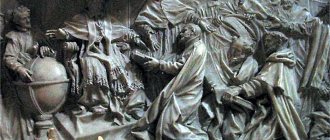On February 6, 1918, the Bolshevik government adopted a decree introducing the Gregorian calendar in the country.
Over the centuries-old history of Russia, the calendar and chronology system have changed more than once. But only once did the country, which was undergoing its largest and most brutal transformation, from the Russian Empire to Soviet Russia, wake up, having lost thirteen days of its life. This happened on the night of February 14, 1918 - the first of the days that Soviet citizens had to live according to the new Gregorian calendar. The decision to introduce it on the territory of the RSFSR was made at a meeting of the Council of People's Commissars on February 6 (January 24, old style) 1918, four days after the church, which continued to live according to the Julian calendar, was also separated from the state by decree.
We change the year, but not the calendar
The twelve-month lunar-solar calendar, which was used in the territory of Ancient Rus', began the year in spring, with the first field work. This rule was preserved even when the Julian calendar, named after Emperor Julius Caesar, who introduced it by decree in 45 BC, reached the ancient Russian state along with Christianity. But the chronology in the calendar, borrowed by the Russians from the Byzantines, remained “Greek” and was carried out from the “day of creation of the world,” which was determined in 5508 BC. In 7000 from the creation of the world (1492 AD), the Orthodox Church changed the start date of the year, moving it to September 1. This decision was not accidental: on this day the year began according to the Byzantine, that is, church calendar. And more than two hundred years later, on December 16, 7208 from the creation of the world (1699 from the Nativity of Christ; rules for calculating compliance, see Table 1), the future Emperor Peter I, by his decree, carried out the first serious civil reform of the calendar in Russia.
Portrait of Tsar Peter Alekseevich in 1698 by the German artist Gottfried Kneller
Source: livejournal.com
From now on, the Tsar ordered that the new year begin not from September 1, and certainly not from March 1, but from January 1, and at the same time replaced the chronology from the creation of the world with the chronology from the Nativity of Christ. So in 1669, Peter’s Russia managed to celebrate the New Year twice - according to the pre-reform calendar and according to the new calendar. The reason for such a reform was obvious: the reformer tsar sought to bring his empire as close as possible to Western European countries. But, changing the chronology and the start date of the year, Peter I did not dare to change the Julian calendar to the Gregorian calendar, which was increasingly spreading in Western Europe. True, it should be noted that by that time many countries with which Russia most actively interacted were still living according to the old style, including Great Britain and Sweden (Holland, from which Tsar Peter Alekseevich borrowed so much, switched to the new style only in the summer of 1700 ). In addition, the Orthodox Church lived according to the Julian calendar, playing a colossal role in Russian life, and the tsar-reformer also did not seek to enter into conflict with it on a not so important issue.
Julian calendar
But counting time only by days is still not very convenient, and I want to have time intervals of a larger scale at hand. Even understanding that no calendar will allow us to describe with absolute accuracy the relationship between the length of the solar day, the tropical year and the synodic month, we can achieve satisfactory accuracy from it. It is in the degree of accuracy in describing the relationship of two of these three intervals that the difference between the Julian calendar and the Gregorian calendar lies.
Both of these calendars are solar, they are designed to connect the duration of the average solar day and the tropical year. We know that from an astronomical point of view, the length of the tropical year is approximately 365.2422 days. To create a calendar, this number must somehow be described so that there is an integer number of days in each calendar year. The easiest way to do this is to vary the length of the year.
The roughest acceptable rounding gives 365.25 days, and it is on this that the Julian calendar is based. If, with such rounding of the average length of the year, we divide the year into 365 days, then for every four years there will be an error of one day. This is where the structure of the calendar comes from, in which every fourth year is a leap year, that is, it includes one more day than usual. The full cycle of such a calendar is only four years, which makes it very easy to use.
The Julian calendar was developed by Alexandrian astronomers, named after Julius Caesar, and introduced into use in 46 BC. It is interesting that initially an additional day was added in a leap year not by introducing a new date - February 29, but by duplicating February 24.
Of course, the Julian calendar is far from the first version of the solar calendar. Thus, the basis for all modern solar calendars was the ancient Egyptian solar calendar. It was counted according to the position of ascending Sirius in the sky and included 365 days. And although the Egyptians understood that with such a counting system, for example, the dates of solstices and equinoxes shifted very quickly, for convenience the length of the year did not change. Therefore, every four years there was a shift of one day, and after 1460 years (this interval was called the Great Year of Sothis) the year returned to its original position.
At the same time, in Ancient Rome itself, the Julian calendar replaced the previously used Roman calendar, which consisted of ten months and included 354 days. To bring the length of the calendar year into line with the length of the tropical year, an extra month was added to the year every few years.
The Julian calendar turned out to be much more convenient than the Roman calendar, but it was still not very accurate. The difference between 365.2422 and 365.25 is still large, so the inaccuracy of the Julian calendar was noticed quite quickly, primarily due to the shift in the date of the vernal equinox. By the 16th century, it had already moved 10 days relative to its initial position, established by the Council of Nicaea in 325 on March 21. Therefore, in order to improve the accuracy of the calendar, it was proposed to make amendments to the existing system of leap years.
Wikimedia commons
Graph of the summer solstice time shift depending on the year according to the Gregorian calendar. The abscissa axis shows the years, and the ordinate axis shows the calculated actual time of the summer solstice in calendar notation (a quarter of a day corresponds to six hours).
Failed reforms
By the beginning of the 19th century, life according to the “old style” began to cause noticeable inconvenience to many subjects of the Russian Empire, primarily to those who, due to duty or personal reasons, were forced to regularly interact with Western European partners. In 1830, the St. Petersburg Academy of Sciences made a proposal to switch to the Gregorian calendar, but this proposal received a negative assessment from the then Minister of Public Education, Prince Karl Lieven. Emperor Nicholas I supported him, and the project was rejected. Three decades later, in 1864, the German astronomer Johann Mädler, who then served as a professor at the University of Dorpat in the Baltics, proposed that the Russian government carry out a calendar reform without changing the chronology itself, but by adjusting the calendar based on his extremely accurate assessment of the year. Professor Medler proposed changing the cycle of three ordinary years and one leap year to a cycle of 128 years, in which there were 31 leap years for 97 ordinary years. The project was rejected by both secular and ecclesiastical authorities, twice: the second time, the Medler calendar was proposed to be introduced in 1899 by a commission organized at the initiative of Dmitry Mendeleev at the Russian Astronomical Society, but this initiative also failed.
Minister of Public Education of the Russian Empire, General of the Infantry, His Serene Highness Prince Karl Lieven
Source: liveinternet.ru
Nevertheless, inconveniences in using the calendar, which did not coincide with the pan-European calendar, accumulated, and the Russian government had to take local measures to overcome them. In particular, even before the First World War, the Gregorian calendar was used for astronomical and meteorological observations, was adopted in the military and commercial fleet, and was used in various situations by the ministries of foreign affairs, finance, communications and internal affairs. It was especially inconvenient for historians: the difference between the calendars accumulated gradually, and dates had to be translated with extreme caution (see Table 2). But for the majority of the Russian population, the discrepancy between the Julian and Gregorian calendars remained invisible. Life in the Russian outback was still largely focused on the church schedule of the year, to which the calendar in force in the country was fully consistent. In order to break this connection and force Russian subjects to stop calculating the year according to the Orthodox calendar, it took the October Revolution with its desire to “destroy the entire old world to the ground.”
Astronomy and calendar
The most common calendars are based on the relationship between the times of three cyclical astronomical processes: the rotation of the Earth around its axis, the rotation of the Moon around the Earth, and the rotation of the Earth itself around the Sun. These three processes lead to periodic changes that are clearly visible on Earth: the change of day and night, the change of phases of the Moon and the alternation of seasons, respectively. The ratio of the durations of these time intervals underlies the overwhelming number of calendars used by humanity. It is clear that there are other astronomical events noticeable to humans on Earth that occur with convenient regularity (for example, in Ancient Egypt they observed the rise of Sirius, which had the same annual cycle), but using them to develop a calendar is still rather an exception.
Of the three indicated intervals, from an astronomical point of view, the easiest to understand is the shortest of them - the length of the day. Now, for the period of time on the basis of which, in particular, calendars are compiled, they take the average solar day - that is, the average period of time during which the Earth rotates around its axis relative to the center of the Sun. Solar days are because the center of the Sun is used as a reference point, and it is necessary to average a day over a year due to the fact that due to the ellipticity of the Earth’s orbit and its disturbance by other celestial bodies, the period of revolution of our planet changes over the course of the year, and the longest and longest short days differ from each other by almost 16 seconds.
A method for determining the duration of a solar day, which is calculated by changing the orientation of the Earth relative to the initial position (1) not by a complete rotation of 360 degrees to position (2), but by one revolution relative to the center of the Sun to position (3)
Wikimedia commons
Share
The second time period needed for a calendar is a year. Of several possible options for determining the period of one year, the calendar uses the seasonal cycle that can be observed when looking at the position of the Sun in the sky from Earth - the so-called tropical year. It is determined by the change in the ecliptic coordinates of the Sun, and one annual cycle corresponds to a change of 360 degrees in its ecliptic longitude (that is, its longitudinal position on the celestial sphere, measured from the vernal equinox point, at which the plane of rotation of the Earth around the Sun and the equatorial plane of the Earth intersect). In this case, the length of the year may vary slightly depending on the choice of the starting point, and, as a rule, the point of the vernal equinox is chosen as the starting position, because for it the error in determining the length of the year is minimal.
The basis of the most common solar calendars today (including the Julian and Gregorian) is the ratio of the time of the daily and annual periods. This ratio, that is, the length of the tropical year in days, is, of course, not an integer and is 365.2422. And how closely the calendar can adjust to this value directly determines its accuracy.
It is worth noting: despite the fact that the duration of one tropical year is almost constant, due to small disturbances in the Earth's orbit it still changes slightly. These disturbances are associated with the influence of the celestial bodies closest to Earth, primarily Mars and Venus, all of them are periodic and have an amplitude of 6 to 9 minutes. The period of each disturbance is two or three years, which together give a 19-year nutation cycle. In addition, the duration of the tropical year does not coincide with the time of the Earth's revolution around the Sun (the so-called sidereal year). This is due to the precession of the earth's axis, which leads to a difference that is now approximately 20 minutes (the length of the sidereal year in days is 365.2564).
The third period of time used to compile calendars is the synodic month. It is counted as the time between two identical phases of the Moon (for example, new moons) and is on average equal to 29.5306 solar days. The phases of the moon are determined by the relative position of three celestial bodies - the Earth, the Moon and the Sun and, for example, do not correspond to the periodicity of the position of the Moon on the celestial sphere relative to the stars. In addition, like the tropical year, the synodic month fluctuates greatly in its length.
Lunar calendars based on the changing phases of the Moon were used quite widely, but in most cases they were replaced by solar or solar-lunar calendars. This is explained both by the inconvenience of using lunar calendars due to noticeable variations in the length of the month, and by the natural linking of human activity to seasonal weather changes, which can be associated with the position of the Sun in the sky, but not with the phase of the Moon. Today, lunar calendars are used mainly to determine the dates of religious holidays. In particular, the Muslim calendar is lunar; the dates of Old Testament Christian holidays, primarily Easter, are also determined using the lunar calendar.
Any calendar is based on attempts to connect at least two of these time intervals. But since any of these ratios cannot be represented in the form of an ordinary fraction, it is impossible to create an absolutely accurate calendar. This problem can be solved in a relatively simple way, without resorting to any calendars at all, but using only one interval, for example, the length of the day. This is what they suggest doing, for example, astronomers who simply count the days starting from a certain point in the past (according to the modern calendar, this point corresponds to noon on November 24, 4714 BC). In this case, any time point is determined by the Julian date - a fractional number that corresponds to the number of days that have passed from the beginning of the countdown.
Wikimedia commons
In the figure above: A method for determining the ecliptic coordinates of a celestial body (for example the Sun) on the celestial sphere. They are counted from the point of the vernal equinox.
Transition gradual or instantaneous
For the first time, the issue of switching from the Julian to the Gregorian calendar was brought up at a meeting of the Council of People's Commissars on November 16 (29 according to the current style) 1917 - just three weeks after the October Revolution. It was decided to postpone the issue until real projects for such a transition were proposed, which obviously required significant efforts. The Council of People's Commissars returned to the topic of a new calendar for the second time two months later, on January 23 (February 5, according to the present day), 1918, when it was presented with two proposals on how to introduce the Gregorian calendar in Soviet Russia. One of them, developed by the People's Commissariat of Public Education, assumed a gradual transition over 13 years, in which each new year the difference between the calendars would be reduced by one day. The second project, which was supported by Assistant People's Commissar for Foreign Affairs Georgy Chicherin, envisaged an immediate transition, which in one day would equalize the dates inside and outside Russia.
Chairman of the Council of People's Commissars Vladimir Lenin, 1918
Source: it.rbth.com
The Chairman of the Council of People's Commissars, Vladimir Lenin, warmly supported just such an “urgent” option. On the one hand, it made it possible to immediately eliminate discrepancies in dates, which was important from the point of view of the unity of the world proletariat and the export of the revolution. On the other hand, such a transition dealt another significant blow to the positions of the Russian Orthodox Church, already separated from the state (the decree on this came into force on that very day), and made it possible to quickly break the connection between it and the majority of the population of Russia, which was one one of the main tasks of the Bolsheviks. The next day, February 6, the decree on the transition to the Gregorian calendar was finally adopted at a meeting of the Council of People's Commissars. Two days later, it was signed by the Chairman of the Council of People's Commissars, Lenin, and the next day, February 9 (January 27, O.S.), 1918, the document was published and came into force.
Difference between new and old styles[edit | edit code]
The difference between the Julian and Gregorian calendars gradually increases due to the different number of leap years: in the Julian calendar, all years divisible by 4 are leap years, while in the Gregorian calendar, a year is a leap year if it is a multiple of 4, but an exception is made for those years that are divisible by 100. Such years are leap years only when they are divisible by 400. The leap occurs in the final year of the century (see Leap year).
Difference between the Gregorian and Julian calendars: October 15, 1582 corresponds to October 5 in the Julian calendar;
other start dates of periods correspond to Julian March 1, end dates - February 29. Difference between Julian and Gregorian calendar dates
| Difference, days | Period (Julian calendar) | Period (Gregorian calendar) |
| 10 | October 5, 1582 – February 29, 1700 | October 15, 1582 - March 11, 1700 |
| 11 | March 1, 1700 - February 29, 1800 | March 12, 1700 – March 12, 1800 |
| 12 | March 1, 1800 – February 29, 1900 | March 13, 1800 – March 13, 1900 |
| 13 | March 1, 1900 - February 29, 2100 | March 14, 1900 – March 14, 2100 |
| 14 | March 1, 2100 - February 29, 2200 | March 15, 2100 – March 15, 2200 |
| 15 | March 1, 2200 - February 29, 2300 | March 16, 2200 – March 16, 2300 |
Due to the increasing change in the difference between the Julian and Gregorian calendars, Orthodox churches using the Julian calendar, starting in 2101, will celebrate Christmas not on January 7, as in the 20th-21st centuries, but on January 8 (translated to the new style), but, for example, from 9901, Christmas will be celebrated on March 8 (new style), although in the liturgical calendar this day will still correspond to December 25 (old style).
In a number of countries where the Julian calendar was in use before the beginning of the 20th century (for example, in Greece), the dates of historical events that occurred before the transition to the new style continue to be celebrated on the same dates (nominally) on which they occurred according to the Julian calendar (which , among other things, reflected in the practice of the Greek section of Wikipedia). In Russia, it is customary to celebrate events that occurred after October 15, 1582, according to the Gregorian calendar.
Similar stories
A similar story happened in America and England in the 18th century, but then the difference between the year calculation systems was smaller, and the British and Americans “lost” only 11 days.
So, 260 years ago, Americans “lost” the date of September 13, 1752, as well as the previous ten days - people went to bed on the evening of September 2, and woke up on the morning of the 14th.
The 11 days between these dates were simply skipped - this was done by order of Parliament, which decided to introduce the Gregorian calendar in order to equalize Britain and its overseas possessions with most of Western Europe.
By the way, China switched to the Gregorian calendar only in 1949. Some other countries a little earlier: Egypt in 1928, Turkey in 1926, Greece in 1924, Romania and Yugoslavia in 1919.











